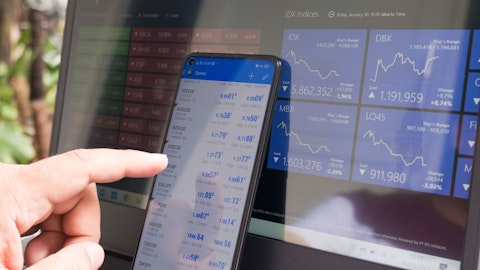Nokia Oyj (NYSE:NOK) Q2 2023 Earnings Call Transcript July 20, 2023
Nokia Oyj misses on earnings expectations. Reported EPS is $0.08 EPS, expectations were $0.09.
David Mulholland: Good morning, ladies and gentlemen and welcome to Nokia’s Second Quarter 2023 Results Call. I’m David Mulholland, Head of Investor Relations. And today with me is Pekka Lundmark, our President and CEO; along with Marco Wiren, our CFO. Before we get started, a quick disclaimer. During this call, we will be making forward-looking statements regarding our future business and financial performance and these statements are predictions that involve risks and uncertainties. Actual results may, therefore, differ materially from the results we currently expect. Factors that could cause such differences can be both external as well as internal operating factors. We have identified such risks in the Risk Factors section of our annual report on Form 20-F which is available on our Investor Relations website.
Within today’s presentation, references to growth rates will mostly be on a constant currency basis. And on margins, we’ll be referring to our comparable reporting. Please note that our Q2 report and the presentation that accompanies this call are published on our website. The report includes both reported and comparable financial results and a reconciliation between the two. In terms of the agenda for today’s call, Pekka will give a quick overview on our financial and strategic progress in the quarter. Marco will then go into a bit more detail of some of the key factors impacting our outlook before Pekka concludes with our outlook 2023. With that, let me hand over to Pekka.
Pekka Lundmark: Thanks to everybody for dialing in today. We highlighted in Q1 that we were starting to see signs of the economic environment impacting customer spending. And already in the second quarter, we saw some of those signs materializing as it started to impact our sales outlook also in network infrastructure. But we still achieved flat year-on-year sales in the quarter as we continue to benefit from market share growth. Despite the regional mix headwinds that are impacting our mobile networks business, we achieved a 38.8% gross margin and an 11-point operating margin. Considering the 40% drop in North America and even adjusting for the €80 million catch-up net sales in Nokia Technologies, that was a pretty resilient result.
If we look specifically at network infrastructure, you do see some divergence in the trends in the business. In IP Networks, we saw some weakness primarily related to CSP spending in North America which led to the 11% drop in net sales. In Fixed Networks, we are seeing two primary effects. Firstly, we are facing some headwinds similar — related to our fixed wireless access business which still today remains sensitive to a small number of customers. And then secondly, as we see some inventory digestion primarily of consumer premise ONT devices. In Optical Networks, we saw a further strong performance of plus 16% as we continue to benefit from the improved competitiveness of our products and market share gains. In fact, while we are seeing weakness elsewhere, our expectations for Optical this year is one area that has actually improved since the start of the year.
In summary, networks, we saw some project timing effects and revenue growth after years of substantial growth but the business remains well supported as it executes on its substantial backlog. From a profitability perspective, the business performed very well. Positive product mix, notably within fixed networks and proactive management of our costs as the sales outlook deteriorated. It meant we were still able to improve our operating margin in NII by 160 basis points to 13.1%. As we look forward, whilst we see some short-term challenges impacting the business, particularly with a softening environment for CSP spending, we remain highly confident in the opportunities ahead for our Network Infrastructure business. In Optical, we continue to believe we are gaining market share.
And with the customer traction of both PSC 5 and now lately with PSC 6, we are very optimistic about the potential to continue to grow in this business. In Fixed Networks, we understand there might be some concerns that we are now seeing some slowdown in sales which is why we want to make it clear, as you see in the chart, that the decline is primarily related to fixed wireless due to its sensitivity to a small number of customers. In fiber, after 2 to 3 years of significant growth, we are now seeing some moderation in growth rates and some short-term inventory digestion but the outlook remains strong for this business with a number of government subsidy programs in both the U.S. and Europe only just starting to benefit the market. In IP Networks, while the uncertainty in CSP is impacting demand currently, we have been making great progress in expanding into enterprise and web scale which has increased from 13% to now over 20% of IP net sales.
Importantly, we believe we are in a strong position to make further progress into web scale into 2024. This diversification should help improve the structural growth opportunities for our IP Networks business, given the enterprise and webscale TAM is expected to grow at around 6% CAGR compared to the 1% growth for CSP customers. Mobile Networks saw 5% growth in constant currency year-on-year as a result of the continuation of the rapid development of 5G in India, where we continue to gain market share. These were partially offset by the expected decline in North America as customers continue to evaluate their spending plans and deplete their inventories in the quarter. Gross margin declined year-on-year, reflecting the regional mix. Given the slower pace of recovery in North America, we now expect the gross margin to only improve towards the end of the year.
With respect to operating margin, a decline in operating expenses, reflecting swift action and cost discipline meant that we achieved 7.9% operating margin, an improvement on Q1. During the quarter, Mobile Networks also launched a series of new products, including basebands, radios and network management and optimization solutions that will drive better performance, lower energy consumption and brings the power of artificial intelligence to Mobile Networks. Cloud and Network Services grew 2% on a constant currency basis, mainly driven by core networks and enterprise solutions. Gross margin declined slightly. However, pleasingly, operating margin improved year-on-year 290 basis points as a result of lower OpEx and other operating income items.

Nokia (NOK) CEO Pekka Lundmark
At the end of June, Nokia reached an agreement to transfer cloud infrastructure portfolio to Red Hat. And starting in Q1 2024, we will adopt the Red Hat platform as our primary reference cloud infrastructure platform for new customers gradually transitioning existing customers over from Nokia’s core networks portfolio. Over 350 Nokia employees are expected to transition to Red Hat to provide continued roadmap evolution, deployment services and support on behalf of Nokia to its customers. One thing to highlight is that just a couple of weeks ago, we signed a long-term patent license agreement with Apple. Obviously, the terms of the deal are confidential but it is one of our longest deals and we are delighted with the outcome. Nokia Technologies saw a 10% increase in constant currency net sales, driven by €80 million of catch-up sales related to deals signed in the quarter.
Excluding these net sales, it would have been on a similar level to Q1. We were pleased to sign a number business deals in Q2. Considering our current base of agreements, we now see that our net sales annual run rate would be €1.1 billion from January 2024 subject to any other material developments. We also continued to renew our industry-leading patent portfolio, reaching the milestone of 5,500 patent families cleared as essential to 5G. Enterprise sales had another successful quarter, growth of 27% in constant currency, a key pillar of our strategy. We continue to make good progress towards our near-term target of having at least 10% of our sales from Enterprise which reached 9% on a last 12-month basis. We continued strong growth in both enterprise verticals and in webscale.
This is particularly benefiting our IP Networks and Optical Networks businesses and we remain confident of our opportunity to grow here, as I already mentioned. We now have more than 635 customers in private wireless and added 90 new customers in Enterprise. With that, I will now handover to Marco to go into a bit more detail on our financial performance.
Marco Wiren: Thanks, Pekka and good morning from my side as well. Looking at our net sales performance by region driven again by the rapid ramp-up sales in India which increased significantly year-on-year in Mobile Networks but also saw growth in Network Infrastructure. In Europe, sales grew by 11%, even excluding the increase in Tech which is recorded in Europe and we had strong profitable business growth. And the growth in Middle East and Africa were mainly driven by Cloud and Network Services and Network Infrastructure. There were declines in Asia Pacific, Latin America and Greater China with mixed performance across the business growth. And then the 40% decline in North America was a result of declines across all business groups as inventory digestion continued and CSPs reevaluated their spending plans.
So in summary, Q2 reflected the trends we had expected to see with rapid India ramp-up being offset by a slowdown in North America. And if we now move to our P&L performance in the quarter. Our comparable operating margin declined 120 basis points year-over-year. And as expected, we saw the negative impact from regional mix continued in the quarter as India sales grew strongly and North America continued to be weak. However, overall margins were rather resilient, benefiting from both quick actions and cost discipline that we took across the businesses as well as the Nokia Technologies catch-up net sales. We also saw a year-on-year increase in operating income. This was mainly related to hedging in addition to income from the sale of certain digital assets in the quarter.
And if we now turn to the operating margin performance by business. As we already mentioned, we were pleased to see the margin performance given the headwinds of growth and regional mix. While Pekka already touched upon many of the drivers, the increases in Nokia Cloud and Network Services and Nokia Technologies were offset by the decline in Mobile Networks margins. Group Common was a net negative on a year-on-year basis, though this is mainly related to venture fund positive that we had last year of €40 million coming to a negative revaluation of €10 million this year. Moving to our cash flow performance in the quarter. We ended quarter two with €3.7 billion of net cash, sequential decline of roughly €600 million. Our free cash flow in the quarter was negative €380 million.
As you can see on this slide, the main driver for the cash burn in the quarter was related to performance-related employee variable pay which included in the liabilities line within net working capital. Otherwise, there were small movements in both receivables and inventories within net working capital. We also returned €250 million of capital to shareholders through our increased dividend and our ongoing share buyback program. And perhaps most importantly, we believe our strong balance sheet, including the €3.7 billion net cash provides us with a firm foundation dedicated to this period of uncertainty. And the final slide for me before Pekka updates you on our outlook for 2023, I wanted to revisit a slide that we showed at the start of the year around our cash conversion.
So we continue to expect the end of the year with a free cash flow conversion of 20% to 50% of comparable operating profit. However, through the first half, we have seen some slight adjustments within this envelope that we wanted to point out. The two main items are: Net working capital which has continued to be a use of cash this year, reflecting the large 5G deployments in India and their impact, both receivables and inventories. The second item is around the gap between Nokia Technologies operating profit and cash which is also reported in net profit. Originally, we expected this to be slightly positive in 2023. And given the deals that we have signed thus far in 2023, we now expect cash flows to be meaningfully higher than operating profit.
Some of the new deals we’ve signed are coming with some modest prepayments for what would have otherwise been received in 2024. And considering there are still a number of details to broke out here, we will give you a more quantitative outlook later in the year. Our long-term vision to have greater alignment between operating profit and cash remains unchanged and we would expect to move towards much greater alignment from 2025 and onwards. So beyond this year, we continue to expect significantly strong cash flow in 2024 as we work towards our longer-term target of 55% to 85% conversion. And with that, let me pass it back to Pekka to go through our revised outlook.
Pekka Lundmark: Thank you, Marco. Let me start by talking about how we see the dynamics unfolding in our market in 2023. We have mentioned a few times already that we see the current macro uncertainty really impacting customer demand this year as inflation and rising interest rates create a greater focus within CSPs on short-term cash flow. This is primarily impacting our Network Infrastructure and Mobile Networks addressable markets. So I want to be clear that this is an industry-wide challenge we face right now and particularly within CSPs and the changes we have made are primarily related to North America. We now forecast 1% constant currency growth in our Network Infrastructure addressable market down from plus 4%, minus 2% in Mobile Networks market, also down from plus 4%.
And our outlook for CNS addressable market remains unchanged at plus 3%. So while we have clearly seen a deterioration in the outlook for our markets in 2023, it should be remembered that there are a number of dynamics that clearly support the need to invest in many of our key end markets which I wanted to revisit. For all of the short-term uncertainty, one thing remains clear, data consumption growth will continue. According to Bell Labs Consulting study, data consumption is forecast to grow at between 20% and 30% CAGR through the end of the decade. Considering all of the data reach applications we see, such as generative AI and also new augmented reality devices coming, we see data consumption growth is a demand. Second, if we look at how 5G has been deployed on mid-band sites across the world, excluding China, we still see plenty of potential.
Approximately only 25% of sites now have 5G mid-band deployed on them. While penetration rates vary by region, even in markets like North America, where significant deployments have already been made, the region is only 55% complete. Other regions like Europe, Latin America and Middle East and Africa are still in the very early stages. So still significant investments needed around the world. Then looking at fiber penetration, you will see that there is still a substantial amount of fiber that needs to be deployed around the world. And perhaps even more importantly, once that fiber is laid, investments will continue for that same fiber for many years to continually drive higher capacity on these lines. Then turning to our full year outlook that we revised last week.
We reduced our net sales outlook for 2023 to €23.2 billion to €24.6 billion from the prior €24.6 billion to €26.2 billion. Proactive action by our business groups to manage cost is largely mitigating the impact to our operating margin and hence, we only narrowed the range to 11.5% to 13% from the prior 11.5% to 14%. You can also see in our report, we have also revised the assumptions by business group for 2023. The main driver here has been around the macro challenges that I’ve already explained in my commentary. In the second half, we expect these trends to continue to impact our business, meaning we now see second half net sales broadly similar to the first half in both Network Infrastructure and Mobile Networks with some sequential improvement visible into Q4.
David Mulholland: Thank you, Marco and Pekka. With that, let’s start the Q&A. As a courtesy to others in the queue, could you please limit yourself to one question and a brief follow-up. Maria, could you please give the instructions?
See also 12 Most Dangerous Countries in Central and South America and 10 Best Sporting Goods Stocks To Buy Now.
Q&A Session
Follow Nokia Corp (NYSE:NOK)
Follow Nokia Corp (NYSE:NOK)
Operator: [Operator Instructions] I will now hand the call back to Mr. David Mulholland.
David Mulholland: Thank you, Maria. We’ll take our first question today from Alex Peterc from Societe Generale.
Alexander Peterc: I hope you can hear me well.
David Mulholland: Yes.
Pekka Lundmark: Yes.
Alexander Peterc: Excellent. So my first question would be on the good OpEx discipline that you demonstrated in your second quarter that protected margins very well. Do you have any specific new restructuring measures in place? And if so, are there any upfront costs that we should be aware of? Or are you using previously planned and provision restructuring budgets? And do you see from here any need for more comprehensive new restructuring plans in the coming quarters? That will be the first one. And then I have a follow-up.
Marco Wiren: Thank you, Alex. I want to point out also that the 5% reduction on year-on-year in OpEx is mainly coming from FX. And excluding the FX, it is largely stable despite, of course, the income deflation environment where we are. In terms of the actions, I just want to highlight that we have taken different actions on short term, when it comes to hiring, travel and also the supply chain costs. And considering the change in our outlook, we also have seen benefit from lower variable pay accruals. But of course, the discipline continue into second half of this year. And I also want to point out that the operational model that we have with decentralized responsibilities, the different businesses, the business leaders in these entities are seeing and taking actions whenever they are seeing a need for that.
So the speed of actions are fast in this new model that we have. What comes to any future restructurings, we will obviously continue to evaluate our cost saves in light of the demand outlook that we have.
David Mulholland: Do you have a follow-up, Alex?
Alexander Peterc: Yes. It’s very clear. My follow-up would be on the achieving problem at the U.S. fixed operators in the last-mile copper network that we heard about in recent days. Now I’d just like to hear your take on the situation. Is this a big liability with a lot of cleanup and legal costs from major operators in North America that may put a pressure on their ability to spend on CapEx? Or is it on the contrary, in your view, a catalyst for total fixed access overall that should be beneficial to you as the market leader in this geography in this market area?
Pekka Lundmark: Yes. Thanks, Alex. I mean, I’m, of course, aware of this reporting and we’ve been following that story. But, however, we don’t have enough information to really be able to comment your question. Of course, environmental impact must always be a priority. And also note that the companies mentioned in the reporting have issued robust statements in response but a specific answer to your question in terms of the impact should really come from the U.S. operators and not from us. We cannot comment that.
David Mulholland: We will take our next question from Francois Bouvignies from UBS.
Francois Bouvignies: So I have two quick one and one is very high level. So Pekka, you mentioned in the video and in fairness, you’re not the only one. Ericsson as well your competitors talking about this data traffic as a driver of demand and investment in the future and you have this chart as well of data traffic. Now if we take a step back and look in the past, I mean the data traffic has been quite strong and yet the revenues has been barely growing for Nokia as a whole at the group level. Of course, you have different mix but you saw differences of data traffic. And revenues basically grows. And it’s true as well for Ericsson, in fairness. So is it the right way to look at data traffic as a growth driver for the business? Or maybe what could change in the future that you could monetize more the data traffic? Maybe that’s my first question.





